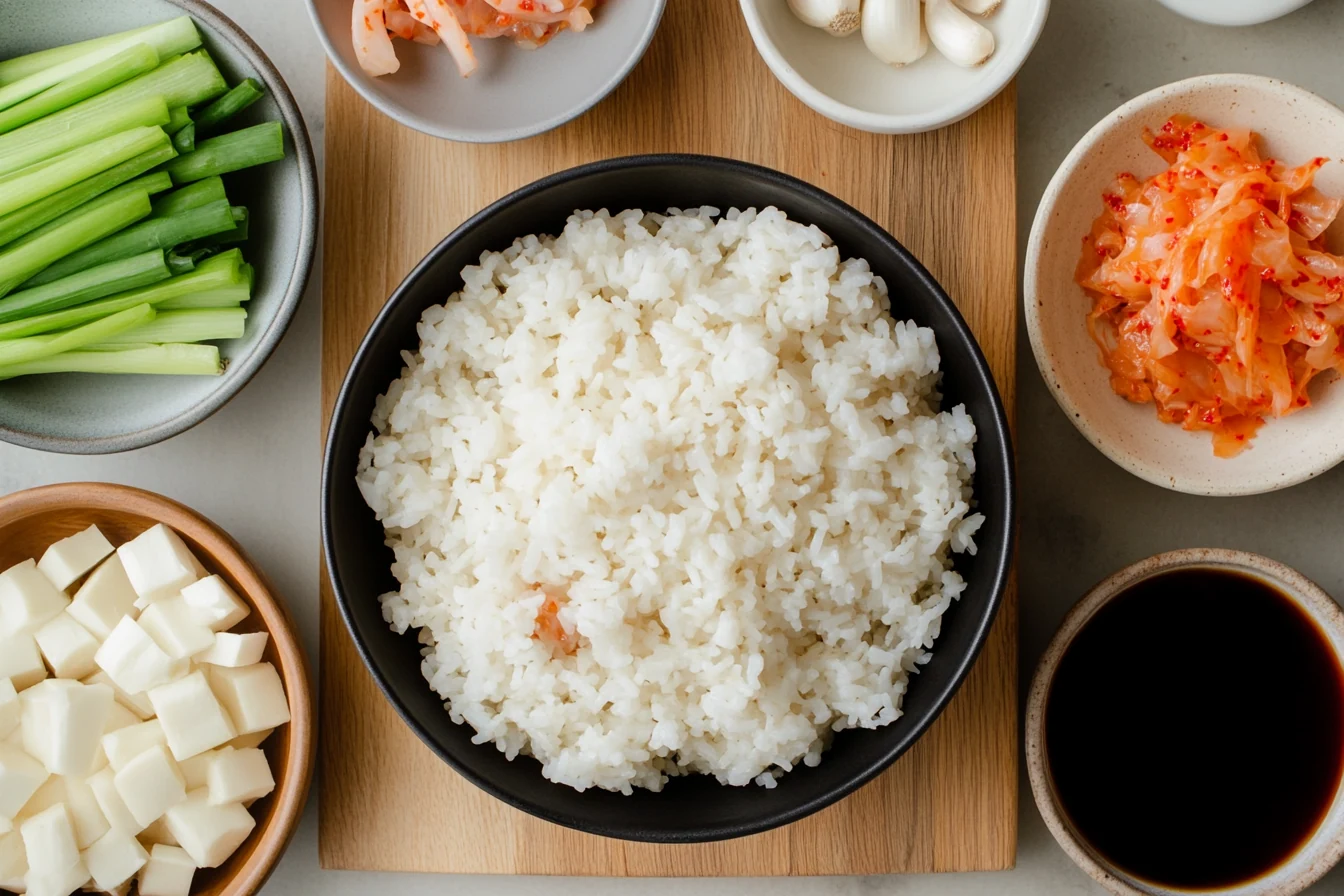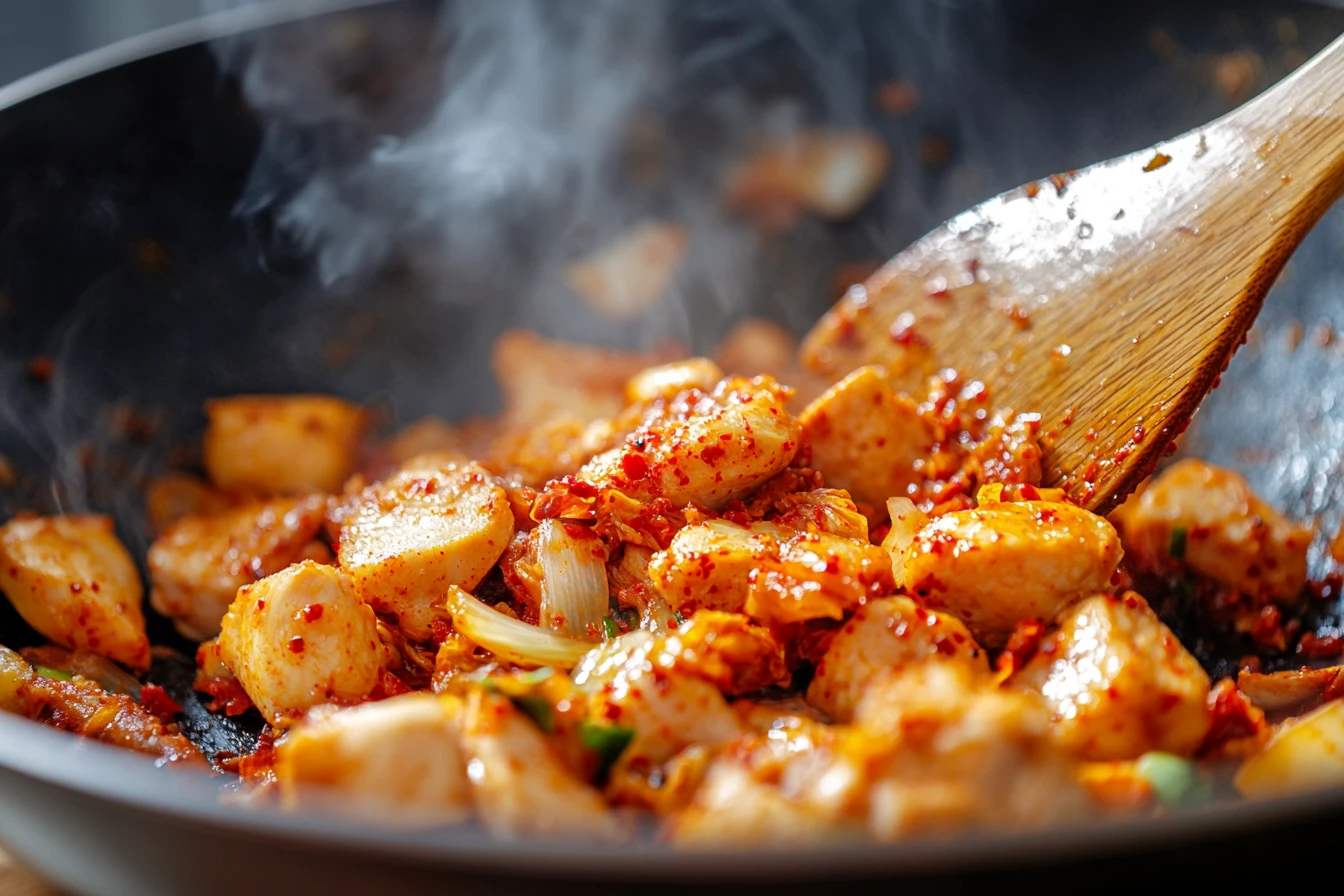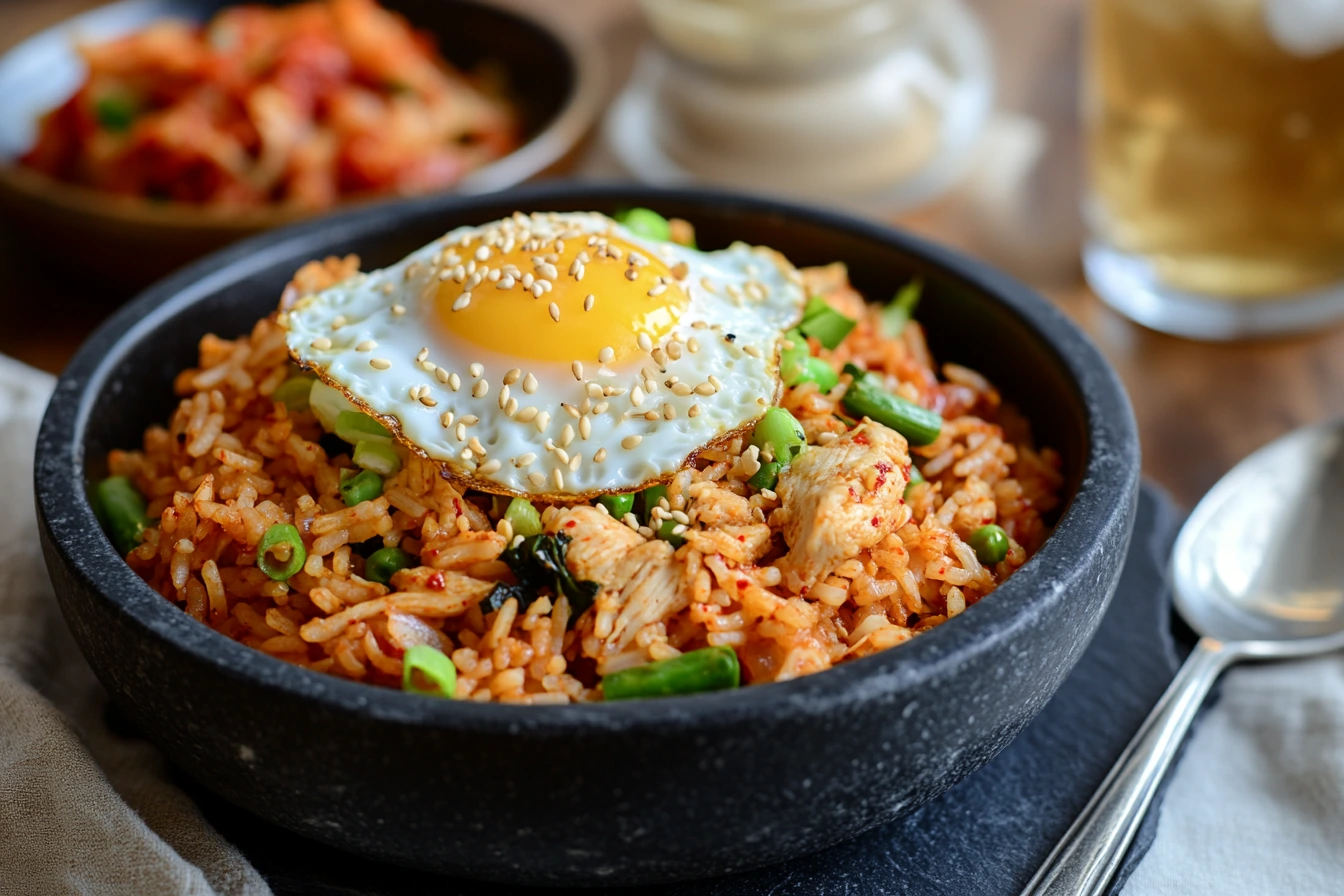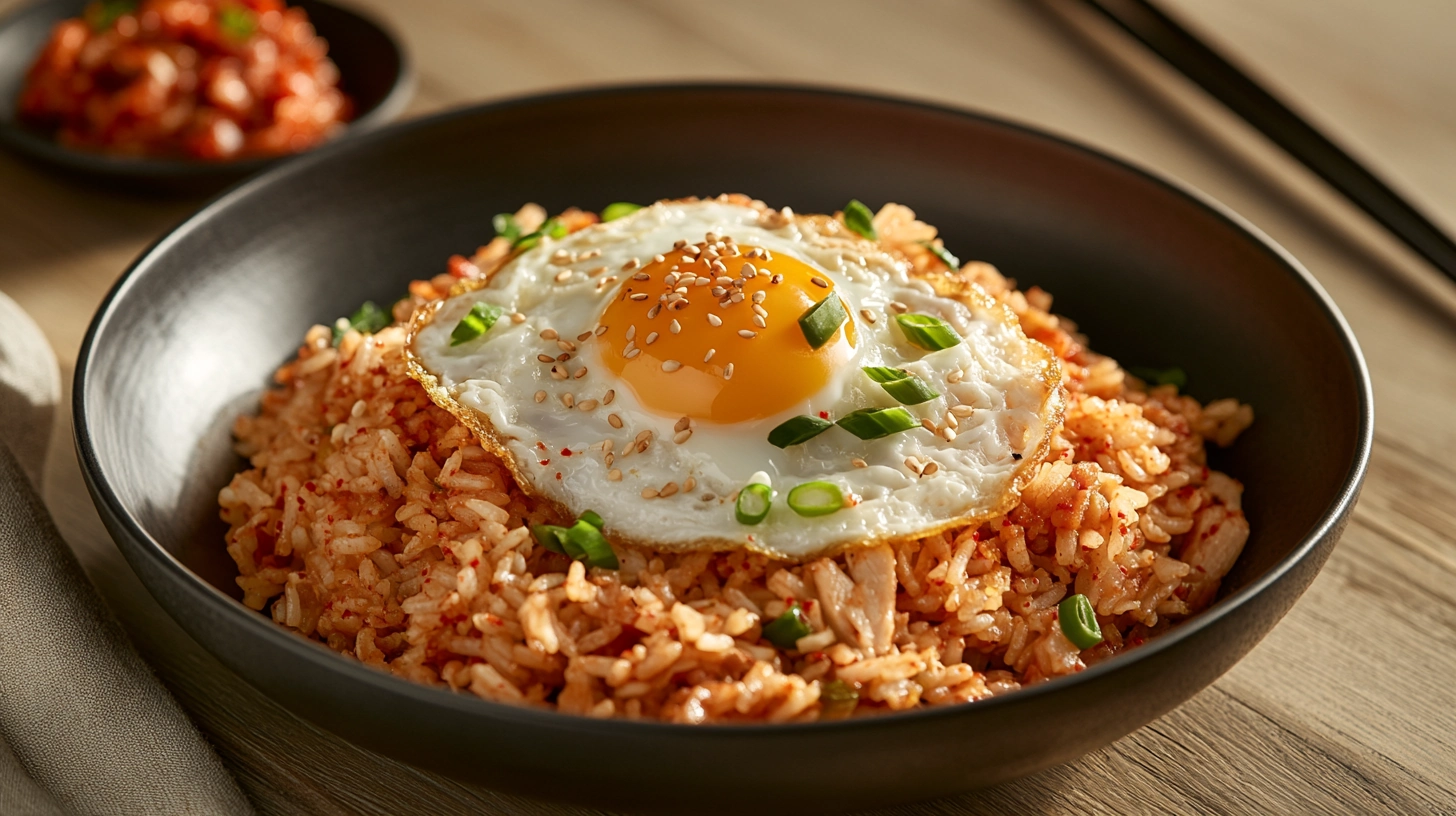If you love bold flavors, kimchi chicken fried rice is the ultimate comfort food with a spicy kick. This dish blends the tangy, umami-rich taste of fermented kimchi with juicy, tender chicken and perfectly stir-fried rice. It’s quick, easy, and packed with mouthwatering flavors that make every bite irresistible.
In This Article
Introduction to Kimchi Chicken Fried Rice
What is Kimchi Chicken Fried Rice?
Kimchi chicken fried rice is a classic Korean-inspired dish made by stir-frying day-old rice, fermented kimchi, chicken, and seasonings like gochujang (Korean chili paste) and soy sauce. The result? A perfectly balanced meal that’s spicy, savory, and slightly tangy.
Unlike regular fried rice, the kimchi gives this dish a deep umami flavor, while the chicken adds a hearty, protein-rich component. Topped with a fried egg, fresh scallions, and a sprinkle of sesame seeds, it’s a delicious one-pan meal that’s both satisfying and easy to make.
The Origins of Kimchi Fried Rice in Korean Cuisine
Fried rice is a global comfort food, but kimchi fried rice—or kimchi bokkeumbap (김치볶음밥)—is a staple in Korean households. The dish was born out of necessity, using leftover rice and overripe kimchi to create something flavorful and hearty. Over time, it evolved, with variations adding ingredients like spam, pork, tofu, and of course, chicken.
Traditionally, Koreans use aged kimchi for this dish because it has a stronger, more developed flavor. The fermentation deepens over time, making it perfect for stir-frying. Many Koreans also consider kimchi bokkeumbap a great way to use up ingredients before grocery shopping, making it a thrifty and sustainable meal.
Why Adding Chicken Makes It a Hearty Meal
While classic kimchi fried rice is often made with just kimchi and rice, adding chicken takes it up a notch. Here’s why:
✅ Extra protein: Chicken makes the dish more filling and nutritious.
✅ Balanced flavors: The savory taste of chicken complements the tangy kimchi.
✅ More texture: Slightly crispy chicken pieces add a great bite to the dish.
For the best results, use boneless chicken thighs for a juicier texture. If you prefer leaner meat, chicken breast works too, but be sure not to overcook it.
Now that you know what makes kimchi chicken fried rice so special, let’s move on to the key ingredients and how they shape the dish.
Ingredients and Their Roles

A great dish starts with the right ingredients. Kimchi chicken fried rice is no exception! Every component in this dish contributes to its rich, bold flavor. Let’s break down the key ingredients and their roles.
Essential Ingredients: Kimchi, Chicken, Rice, and Seasonings
For an authentic taste, you’ll need:
- Kimchi – The heart of the dish. Fermented kimchi provides that signature tangy, spicy, umami-rich flavor. Aged kimchi works best since it has a deeper taste.
- Chicken – Adds protein and texture. You can use either chicken breast for a leaner option or chicken thighs for juicier results.
- Rice – Day-old rice is ideal because it’s drier, preventing the dish from becoming mushy.
- Gochujang (Korean chili paste) – Boosts the spiciness and gives a slightly smoky-sweet depth.
- Soy sauce – Enhances umami and adds saltiness.
- Sesame oil – Provides a nutty aroma that brings all the flavors together.
- Garlic & scallions – Essential aromatics that intensify the dish’s depth.
Choosing the Right Kimchi for Fried Rice
Not all kimchi is the same! For kimchi chicken fried rice, use:
- Napa cabbage kimchi – The most common type, balancing spice and crunch.
- Overripe kimchi – Aged kimchi is more fermented, bringing out deeper flavors when stir-fried.
- Homemade vs. store-bought – Store-bought kimchi works well, but if you have homemade kimchi, even better!
Best Type of Rice to Use for Perfect Texture
Rice is the foundation of this dish, so choosing the right kind is crucial:
- Best option: Day-old short-grain or medium-grain rice – Less sticky and fries well.
- Worst option: Freshly cooked rice – Too moist, making the fried rice clumpy.
- Alternative choices: Brown rice for a healthier twist, quinoa for extra protein, or cauliflower rice for a low-carb option.
Other Optional Ingredients for Customization
Want to take your kimchi chicken fried rice to the next level? Try these:
- Eggs – A fried egg on top or scrambled into the rice adds richness.
- Cheese – A Korean street-food twist—melted cheese balances out the heat.
- Bacon or ham – A salty, smoky kick pairs beautifully with kimchi.
- Vegetables – Mushrooms, carrots, or zucchini boost nutrition and texture.
Now that we’ve covered the ingredients, let’s get to the exciting part—cooking!
Step-by-Step Cooking Guide

Making kimchi chicken fried rice is easier than you think! Just follow these simple steps to achieve the perfect balance of flavors and textures.
Preparing the Ingredients Before Cooking
Before you start, get everything ready:
- Chop the kimchi into small pieces, reserving some of the kimchi juice for extra flavor.
- Cut the chicken into bite-sized pieces. Marinate with a bit of soy sauce and garlic for added taste.
- Measure out the rice, seasonings, and aromatics so everything is within reach.
Cooking the Chicken to Perfection
- Heat a wok or large skillet over medium-high heat.
- Add a little oil, then cook the chicken until golden brown.
- Remove the chicken from the pan and set aside.
Sautéing Kimchi for Maximum Flavor
- In the same pan, add a touch of oil, then toss in the chopped kimchi.
- Stir-fry for 2-3 minutes until the kimchi becomes slightly caramelized—this step deepens its flavor.
- Add gochujang and a splash of kimchi juice for an extra flavor boost.
Combining Everything and Achieving the Right Consistency
- Return the cooked chicken to the pan.
- Add the rice, breaking up any clumps with your spatula. Stir well to coat the grains in kimchi goodness.
- Pour in a dash of soy sauce and sesame oil to enhance the aroma and taste.
- Stir-fry everything together for about 3-5 minutes until heated through.
The Perfect Finishing Touches: Eggs, Sesame Oil, and Garnishes
To serve your kimchi chicken fried rice like a pro:
- Top with a fried egg – The runny yolk makes the dish creamy and rich.
- Garnish with chopped scallions for freshness.
- Sprinkle sesame seeds or shredded seaweed for extra umami.
And there you have it! A spicy, flavorful, and utterly delicious plate of kimchi chicken fried rice.
Variations of Kimchi Chicken Fried Rice
One of the best things about kimchi chicken fried rice is its versatility. You can tweak the ingredients and spice levels to suit your tastes or dietary preferences. Let’s explore some fun variations of this dish!
Spicy vs. Mild: Adjusting Heat Levels
Kimchi chicken fried rice is known for its heat, but it’s easily customizable to match your spice tolerance:
- Extra spicy: Add more gochujang (Korean chili paste) or a handful of chili flakes.
- Mild: Reduce the amount of gochujang and opt for a milder kimchi.
- Heat-free option: If you’re avoiding spice, use non-spicy kimchi and skip the gochujang altogether.
Remember, the kimchi you use will also impact the heat level, so choose one based on your preference.
Vegetarian and Vegan Alternatives
For those who follow a plant-based diet, kimchi chicken fried rice can easily be made vegetarian or vegan:
- Tofu: Use firm tofu as a protein substitute. Pan-fry it until crispy for added texture.
- No egg? Simply skip the fried egg on top or use a vegan egg substitute.
- Veggie-filled version: Add extra vegetables like mushrooms, peas, or carrots to make the dish more filling.
These alternatives still pack all the flavors and richness of the original, but with a plant-based twist.
Adding Cheese for a Creamy Texture
If you love cheese, try adding a handful of shredded cheese to your kimchi chicken fried rice. It melts perfectly, giving the dish a creamy, gooey texture that complements the spicy and tangy kimchi. This variation is popular in Korean street food and is worth trying if you want to indulge a little more!
Making a Healthier Version with Brown Rice or Quinoa
For a healthier spin on this classic, swap out white rice for:
- Brown rice – Rich in fiber and nutrients.
- Quinoa – A protein-packed, gluten-free alternative that adds a unique texture.
These options will make your kimchi chicken fried rice just as delicious while being lighter and more nutritious.
Tips and Tricks for the Best Kimchi Chicken Fried Rice
Achieving the perfect kimchi chicken fried rice requires a few tricks to ensure the flavors are balanced and the rice is just right. Let’s dive into some expert tips!
Using Day-Old Rice vs. Freshly Cooked Rice
As mentioned earlier, using day-old rice is key to making perfect fried rice. But why? Here’s why it works better:
- Day-old rice is drier and less sticky, which allows each grain to fry separately, resulting in a better texture.
- Fresh rice is too moist, making it difficult to fry and often leading to a soggy dish.
So, if you’re short on time, prepare your rice ahead of time and let it cool in the fridge.
How to Prevent Soggy Fried Rice
If you’ve ever ended up with a plate of mushy fried rice, you know how disappointing it can be. Here’s how to avoid it:
- Don’t overcrowd the pan – Fry the rice in batches if needed.
- Use enough oil – This helps separate the grains and adds flavor.
- Stir-fry at high heat – This will help evaporate any excess moisture, giving your rice that perfect crispy texture.
Boosting Umami Flavors with Secret Ingredients
To elevate your kimchi chicken fried rice, consider adding a few umami-rich ingredients:
- Fish sauce – Adds a salty, savory depth.
- Miso paste – Provides a rich, fermented flavor.
- Sesame seeds or sesame paste – Adds a nutty finish to the dish.
These ingredients can transform your kimchi chicken fried rice into something truly special!
Making It in Advance and Storing Leftovers Properly
Kimchi chicken fried rice is perfect for meal prep. If you have leftovers, simply:
- Store in an airtight container for up to 2 days in the fridge.
- Reheat on the stovetop or in the microwave, adding a little bit of water or oil to keep it moist.
Leftovers also taste great the next day, with the flavors even more developed.
Serving Suggestions and Pairings

A great dish is even better when paired with the right sides and drinks. While kimchi chicken fried rice is a complete meal on its own, adding a few complementary items can elevate the dining experience.
Best Side Dishes to Serve with Kimchi Chicken Fried Rice
If you want to turn this dish into a full Korean-style meal, try serving it with:
- Korean pickled radish (danmuji) – Its sweet and tangy flavor balances the spice.
- Korean seaweed soup (miyeok-guk) – A light and nutritious option.
- Spicy Korean cucumber salad (oi muchim) – Adds freshness and crunch.
- Kimchi pancakes (kimchi jeon) – A crispy, savory side that pairs well.
These sides enhance the taste and texture of kimchi chicken fried rice, making every bite more satisfying.
Drinks That Complement the Dish
With a bold and spicy dish like kimchi chicken fried rice, the right drink can cool things down:
- Iced barley tea (boricha) – A popular Korean drink with a toasty flavor.
- Soju or makgeolli – If you’re in the mood for a traditional Korean alcoholic pairing.
- Sparkling water with lime – Refreshing and helps cleanse the palate.
If you prefer something creamy, a mango lassi or banana milk can mellow out the spice while adding a slight sweetness.
Creative Ways to Serve It
Want to make kimchi chicken fried rice even more fun? Try these serving ideas:
- Stuff it into a burrito – A fusion twist with some melted cheese.
- Top it with extra protein – Add grilled shrimp, beef, or even tofu.
- Wrap it in lettuce leaves – A low-carb, Korean-inspired way to enjoy it.
Experiment with different ways to serve it based on your mood and occasion!
Frequently Asked Questions (FAQ)
Before you get started on making kimchi chicken fried rice, here are answers to some common questions people have.
Can I Use Fresh Rice Instead of Day-Old Rice?
Yes, but it’s not ideal. Freshly cooked rice tends to be too moist, which can make your fried rice mushy. If you must use fresh rice, spread it on a plate and let it cool for about 30 minutes before stir-frying. This helps remove excess moisture.
What Kind of Chicken Works Best—Breast or Thigh?
Both work, but chicken thighs are preferred because they stay juicier and more flavorful. Chicken breast is leaner and can work well, but be careful not to overcook it, as it can become dry.
How Long Can I Store Leftovers, and How Should I Reheat Them?
Leftover kimchi chicken fried rice can be stored in an airtight container in the fridge for up to 2 days. To reheat:
- On the stovetop – Heat in a pan with a small splash of oil or water to restore moisture.
- In the microwave – Cover and heat in short intervals, stirring in between.
For the best texture, the stovetop method is recommended.
Can I Make This Dish Less Spicy for Kids?
Absolutely! To make a milder version, reduce or skip the gochujang and use mild kimchi. You can also mix in a little honey or cheese to balance out the spice.
Common Mistakes to Avoid When Making Kimchi Chicken Fried Rice
Even though kimchi chicken fried rice is a simple dish, a few small mistakes can impact the flavor and texture. Here’s what to watch out for when making it at home.
Using Freshly Cooked Rice Without Drying It First
One of the biggest mistakes is using freshly cooked rice straight from the pot. Since it’s full of moisture, it can turn your fried rice soggy and clumpy instead of light and fluffy.
✅ Fix: If you don’t have day-old rice, spread fresh rice on a tray and let it cool for 30 minutes before using. You can also refrigerate it for faster drying.
Not Cooking the Kimchi Long Enough
Kimchi is packed with flavor, but if you don’t sauté it long enough, it won’t release its full umami-rich taste.
✅ Fix: Cook the kimchi for at least 2-3 minutes before adding rice. This allows it to caramelize slightly and deepen in flavor.
Adding Too Much Liquid
Too much soy sauce or kimchi juice can make the dish too wet, which prevents the rice from frying properly.
✅ Fix: Start with small amounts of sauce and adjust as needed. A tablespoon or two is usually enough to season the dish without making it soggy.
Skipping the Egg or Garnishes
A fried egg, sesame seeds, and scallions might seem optional, but they enhance the dish’s flavor and texture.
✅ Fix: Always add a fried egg on top for a creamy contrast, and sprinkle sesame seeds and scallions for freshness.
By avoiding these common mistakes, you can ensure that your kimchi chicken fried rice turns out flavorful and restaurant-quality every time.
How to Make Restaurant-Style Kimchi Chicken Fried Rice at Home
If you’ve ever had kimchi chicken fried rice at a Korean restaurant, you know it has a unique, smoky flavor and the perfect balance of spice and umami. Want to recreate that at home? Here’s how.
Use a Wok for the Best Results
Restaurants use high heat and a wok to give their fried rice that distinct charred, smoky aroma. The curved shape of a wok allows for better heat distribution, which prevents the rice from getting soggy.
✅ Tip: If you don’t have a wok, use a large cast-iron skillet to achieve a similar effect.
Incorporate Gochugaru for Extra Flavor
Many restaurants add gochugaru (Korean chili flakes) to their kimchi chicken fried rice for an extra layer of spice and smokiness.
✅ Tip: Sprinkle ½ teaspoon of gochugaru while stir-frying the kimchi to enhance the dish’s depth.
Finish with Butter for a Rich, Velvety Taste
A secret trick used in many Korean fusion restaurants is adding butter at the end of cooking. This gives the rice a smooth, restaurant-style finish while balancing out the spice.
✅ Tip: Stir in ½ tablespoon of butter just before serving to add richness without overpowering the dish.
Serve It in a Hot Stone Bowl (Dolsot)
For an authentic Korean experience, serve your kimchi chicken fried rice in a dolsot (Korean stone bowl). The hot stone crisps up the bottom layer of rice, giving it a delightful crunch, similar to Korean bibimbap.
✅ Tip: Preheat the stone bowl with a little sesame oil, then press the rice down to form a crispy layer.
For more Korean recipes, check out Korean Bapsang for inspiration.
For more quick and flavorful meals, check out:
- Zero-Waste Recipes: Sustainable Cooking – Learn how to make eco-friendly dishes with leftovers.
- Carrot Top Chimichurri Recipe – A delicious way to use up carrot greens.

